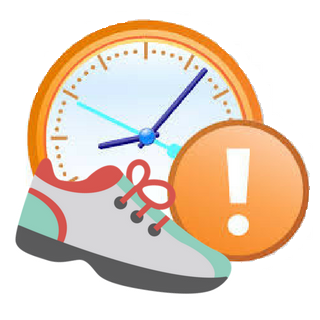Healthy Nurse, Healthy Nation™ Blog - Sneak Fitness Into Your Routine
The good news is that you don't have to be in a gym to sneak some fitness into your daily routine. Heidi Rye, an RN and certified group fitness instructor, has shared some great ideas on how to incorporate fitness moves into your routine, if you’re crunched for time.
Balancing an 8-12-hour work day with the added pressures of family and/or school life commitments can be quite demanding for the average nurse. It is so difficult to squeeze in a workout, before or after work, that 49% of us don't achieve the recommended amount of physical activity due to time constraints, fatigue, and low motivation. Test out some of these suggestions and let us know what you think and how you choose to fit fitness into your routine.
Break it down
The American Heart Association recommends that adults aim for 30 minutes of physical activity per day, five days per week. The good news: you can break it down into small bits throughout the day and any amount of activity will benefit you. Every little bit helps. As Wellnitz-Rye says, “small blocks of five or 10 minutes per day is better than zero.”
Exert yourself
The Centers for Disease Control and Prevention (CDC) suggest that the benefits of increasing your heart rate not only puts you at lower risk for cardiovascular disease, type II diabetes, and some cancers, but it also can help with controlling weight, strengthening your bones and muscles, and improving your mood and mental health. Challenge yourself to get creative in trying to increase the intensity of your daily mundane activities. For example, skip the elevator and take the stairs! Hitting the steps when taking the stairs does double duty since it increases your heart rate and works your lower body with weight-bearing exercise. Try to get up or down stairs as safely as possible, but faster than you usually do. Not intense enough? Climb steps two at a time when going up. Use CDC’s Talk Test to determine how hard you’re working. For moderate intensity activities, you should be able to talk but not sing. At a vigorous intensity, you shouldn’t be able to say more than a few words at a time without pausing for a breath.
Use fitness aids
Get on the "band" wagon – keep a lightweight exercise band in your pocket or resistance bands in your desk drawer and do bicep curls or tricep extensions during down times or while on hold on the phone.
Sit on a ball – ever considered swapping out your desk chair for an exercise ball? Trying to balance on a ball not only increases core strength but also flexes your leg and hip muscles. Just make sure that you get an exercise ball with an anti-burst rating of 500kg - you want it to be able to withstand your body-weight, plus any additional weight, so it doesn’t burst.
Step it up – get a fitness wearable, pedometer, or use that built-in health app on your smartphone to track your steps. Don't have one? Just search for a free step tracker in your phone's app marketplace. On average nurses can walk up to 5 miles per shift! How many steps do you think you take in a shift? Track them and challenge yourself or a co-worker to do better.
Maximize your commute
Incorporate exercise into travel time. Don't live that far from home? Ride your bike to work. Drive? Park at the farther away and walk a longer distance. Take public transportation? Get off one stop earlier and walk the final leg to your destination. Not intense enough? Walk at a faster pace than usual.
Stop and stretch
Get your back in the game. According to the Mayo Clinic, proper stretching can decrease your risk of injury and increase blood flow to your muscles. Doing back stretches is a great way to improve your posture and engage your core. If you can, set a reminder on your phone every hour and stretch. Try a simple stretch, reaching toward the sky, touching your toes, or pulling your shoulder blades back while standing up straight. Can't do this throughout the day? Try some stretches with a foam roller first thing in the morning or right before bed.
Flex your muscles
The American Heart Association suggests that weight-bearing exercise improves quality of life as a result of increased muscle mass and strength, stronger bones and connective tissues, and decreased risk of injury. Stronger muscles allow us to better practice Safe Patient Handling and Mobility (SPHM) so that we don't compromise our own health while caring for patients. Weight bearing exercises are also beneficial in maintaining a healthy weight and burning calories. The CDC’s Physical Activity Guidelines for Americans recommends performing muscle-strengthening exercises two or more days per week, but incorporating resistance training into your day doesn’t have to mean lifting weights at the gym. Use your body weight to flex those muscles! Filling out a patient’s chart? Do calf raises while you work. Mimic this at home, while doing simple chores like washing dishes or in front of your mirror or while brushing your teeth.
Help yourself, help your patients
15 years of gallup polls amongst Americans show that nurses are the most trusted profession with the highest honesty and ethical standards. We are known to lead by example. When we are physically active, we are more likely to encourage patients and family members to develop active lifestyle habits. That’s why physical activity is a pillar of Healthy Nurse, Healthy Nation™ (HNHN), a social movement transforming the health of the nation by improving the health of nurses first.
Challenge yourself to take the next step. What are you going to do to better incorporate fitness into your daily life? Tag a nurse and challenge them to do the same. These are your challenges, your stories and your successes. Share them with us and each other. Leave a comment in our "Increasing Physical Activity" discussion or tag us on Facebook, Twitter, or Instagram with #HealthyNurse.
Source List:
Albert, N. M., Butler, R., Sorrell, J., (September 30, 2014) "Factors Related to Healthy Diet and Physical Activity in Hospital-Based Clinical Nurses" OJIN: The Online Journal of Issues in Nursing Vol. 19, No. 3, Manuscript 5.
Bakhshi, S., Fei, S., Murrells, T., & While, A. (2015). Nurses’ health behaviors and physical activity- related health-promotion practices. British Journal of Community Nursing, 20, 289-296.
https://www.cdc.gov/physicalactivity/basics/pa-health/index.htm
https://www.cdc.gov/physicalactivity/basics/adults/index.htm
http://www.heart.org/HEARTORG/HealthyLiving/PhysicalActivity/FitnessBasics/Strength-and-Resistance-Training- Exercise_UCM_462357_Article.jsp#.WLYxSBIrJSw
http://www.mayoclinic.org/healthy-lifestyle/fitness/in-depth/stretching/art-20047931
http://www.prevention.com/fitness/fitness-tips/should-you-replace-your-office-chair-stability-ball
Speroni, K., (September 30, 2014) "Designing Exercise and Nutrition Programs to Promote Normal Weight Maintenance for Nurses" OJIN: The Online Journal of Issues in Nursing Vol. 19, No. 3, Manuscript 6.
Find this helpful? Consider sharing it with a friend by clicking on the social media icons on the left side of this page. Don't forget to tag us with #HealthyNurse. Find us on Facebook, Twitter, or Instagram. Have you joined the Healthy Nurse, Healthy Nation (HNHN) Grand Challenge yet? Join us today!
Have you joined the Healthy Nurse, Healthy Nation (HNHN) Grand Challenge yet? Join us today!
Reviewed 12/8/22




Post a Comment or Question